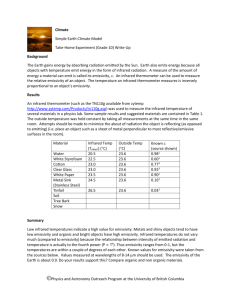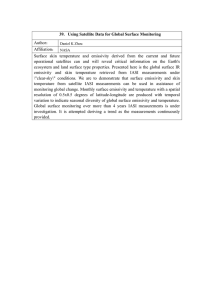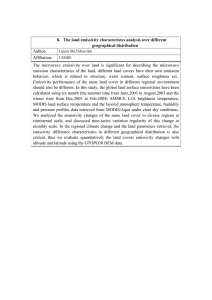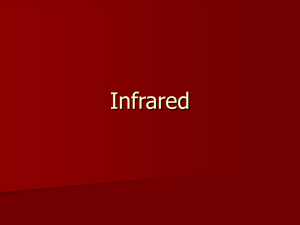Selecting Non Contact Pyrometers and Infrared Thermometers
advertisement
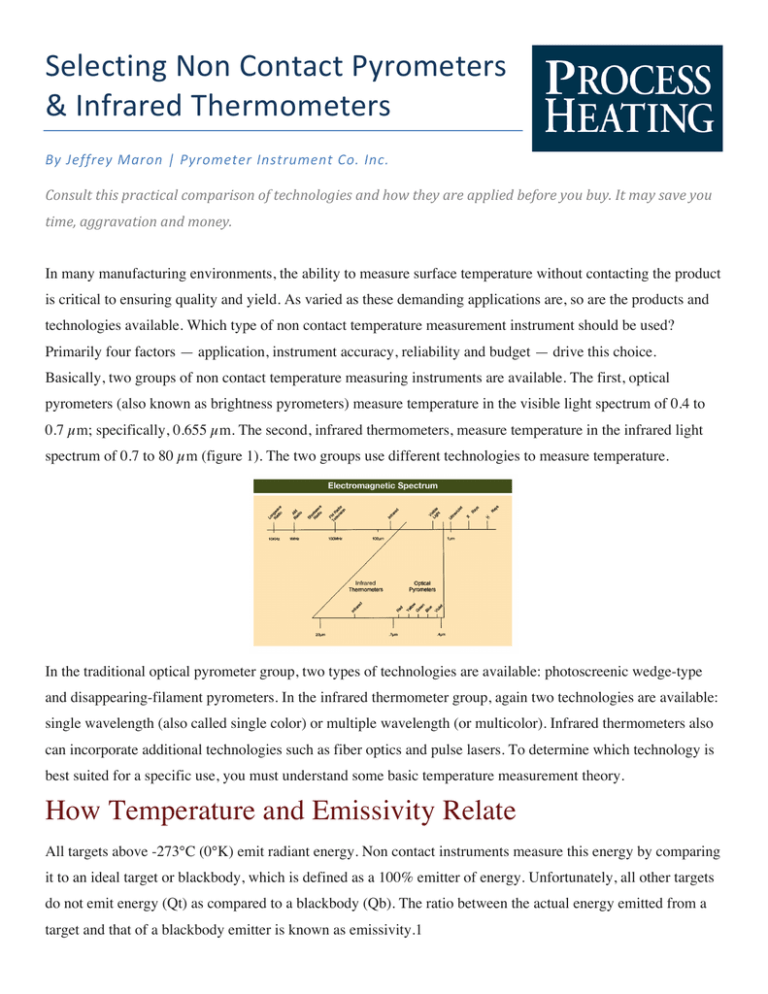
Selecting Non Contact Pyrometers & Infrared Thermometers By Jeffrey Maron | Pyrometer Instrument Co. Inc. Consult this practical comparison of technologies and how they are applied before you buy. It may save you time, aggravation and money. In many manufacturing environments, the ability to measure surface temperature without contacting the product is critical to ensuring quality and yield. As varied as these demanding applications are, so are the products and technologies available. Which type of non contact temperature measurement instrument should be used? Primarily four factors — application, instrument accuracy, reliability and budget — drive this choice. Basically, two groups of non contact temperature measuring instruments are available. The first, optical pyrometers (also known as brightness pyrometers) measure temperature in the visible light spectrum of 0.4 to 0.7 µm; specifically, 0.655 µm. The second, infrared thermometers, measure temperature in the infrared light spectrum of 0.7 to 80 µm (figure 1). The two groups use different technologies to measure temperature. In the traditional optical pyrometer group, two types of technologies are available: photoscreenic wedge-type and disappearing-filament pyrometers. In the infrared thermometer group, again two technologies are available: single wavelength (also called single color) or multiple wavelength (or multicolor). Infrared thermometers also can incorporate additional technologies such as fiber optics and pulse lasers. To determine which technology is best suited for a specific use, you must understand some basic temperature measurement theory. How Temperature and Emissivity Relate All targets above -273°C (0°K) emit radiant energy. Non contact instruments measure this energy by comparing it to an ideal target or blackbody, which is defined as a 100% emitter of energy. Unfortunately, all other targets do not emit energy (Qt) as compared to a blackbody (Qb). The ratio between the actual energy emitted from a target and that of a blackbody emitter is known as emissivity.1 How does this apply to your application? Energy (Q) applied to a target is either absorbed (A), reflected (R) or transmitted (T). Therefore, A + R + T = 100% of energy Consider an example. Assume that 90% of the energy is absorbed, 10% of the energy is reflected, and 0% of the energy is transmitted. This is expressed as the following equation. 0.90 + 0.10 + 0.00 = 100% of the energy Optical pyrometers and infrared thermometers only can detect radiance of opaque objects; as a result, transmitted energy is removed from the equation. (Keep in mind that targets such as glass or silicon may be transparent or translucent at one wavelength yet opaque at another; thus, operating wavelength becomes a factor in instrument selection.) This simplifies the above equation to: A + R = 100%, or 0.90 + 0.10 = 100% Additionally, the amount of energy being emitted from a target is equal to the amount of energy being absorbed by the target. Therefore, absorbed energy (Qt) equals emitted energy, according to Kirchoff’s Law. More importantly, a target’s emissivity value now can be explained as the ratio of "how well" or "how poorly" a target at a given temperature and wavelength emits or radiates thermal energy in comparison to an ideal 100% blackbody emitter. Emissivity (E)= Energy Emitted From Target (Qt) Energy Emitted From Blackbody (Qb) To demonstrate these principles, consider an example. Assume a non contact thermometer is operating at 0.865 µm wavelength. This thermometer is used to measure the temperature of a target emitting 80% of its energy as compared to a blackbody (expressed as 0.8 emissivity). The thermometer indicates a temperature of 1,794°F (979°C). Because the target is not a blackbody emitter, a measurement error is introduced comparative to the value in emissivity. While the non contact thermometer reads 1,794°F (979°C), the true target temperature is 1,832°F (1,000°C). This represents a potential 2.1% temperature measurement error. As a rule, the lower the emissivity value, the larger the difference in potential temperature measurement error. Emissivity is subject to both wavelength (µm) and temperature. As a result, readings obtained from a single target, measured at two different wavelengths, can be affected by diversely different emissivity values. Additionally, readings obtained from a single target, measured at two different temperatures but at the same wavelength, also can have different emissivity values. Obviously, knowing the emissivity of a target is critical to determining true target temperature. Both optical and infrared temperature measurement instruments are impacted by emissivity. Most infrared thermometers provide an adjustment knob to compensate for emissivity. Regardless of the instrument being used, emissivity must be addressed based on the center wavelength of the spectral band being utilized. Special consideration should be given to applications where the emissivity changes quite rapidly as the target temperature increases or decreases. This is a common phenomenon for some materials. Where does the operator set his fixed emissivity value? This is an inherent weakness of non contact temperature measurement. In this case, infrared thermometers that incorporate pulse laser automatic emissivity correction are quite effective. How the Application Impacts Temperature Measurement Many factors influence the choice of the appropriate temperature measurement instrument for a given application. Physical factors include: • Target temperature range. • Target material. • Target size. • Target distance. • Interfering gases. • Ambient temperature. Other factors play an equally significant role. For example, will the instrument be used as part of an integrated process control solution? Or, does the application require only occasional measurements that are obtained as reference data? Also, keep in mind that all non contact pyrometers and infrared thermometers will read all of the energy in their field of view within their spectral band. Various materials and operating environments — flames, gases, particulate or other obstructions in the instrument’s field of view — can negatively impact measurement accuracy. The instrument also will measure additional sources of energy, including reflected (R) energy, if they are in the instrument’s field of view. This can result in an integrated temperature measurement rather than an accurate reading of the target. Accuracy is an important factor when selecting a non contact pyrometer or thermometer to ensure product yields and quality. Ask two questions about the application: First, does the application require accuracy? Second, does the instrument being considered have the accuracy to suit the application? It does not make sense to utilize an instrument with high accuracy when the application does not require it, or vice versa. Keep in mind, though, that instrument accuracy has a higher price. Usually, instrument accuracy is defined by the manufacturer as one of the following: percentage of temperature displayed; percentage of temperature range; or plus or minus a temperature value. Note that this definition typically is made in the absence of emissivity. Therefore, when emissivity values are imposed, temperature accuracy is further affected. Optical Pyrometers: Function and Operation Traditional optical pyrometers measure brightness in the visible spectrum. By using the inherent ability of the human operator’s eye, the unknown intensity of light radiated from a hot target at 0.655 µm wavelength is compared to the known brightness of an internal, calibrated lamp. Because the human eye can see reflected energy "glare," it is somewhat more effective with nondiffuse or shiny targets than infrared thermometers. These lightweight, portable instruments are effective for certain types of applications. Temperature measurements obtained with an optical pyrometer are accurate when compared to a blackbody temperature source. But, optical pyrometers are affected by emissivity in the same manner as infrared thermometers; therefore, they require emissivity temperature compensation for non-blackbody-target temperature measurements. Wedge-Type Optical Pyrometer. A wedge-type optical pyrometer’s optical lenses and prisms provide a clear, enlarged view of the target (figure 2). The instrument incorporates a rotating optical photoscreenic wedge that functions as a neutral density filter. Brightness from a hot target, sighted through the optical system, is varied by rotating the internal wedge until the target’s intensity matches that of the internal calibrated lamp. The temperature scale around the outside of the optical pyrometer is directly coupled to the instrument’s optical wedge. Typical temperature ranges for optical pyrometers are approximately 1,300 to 5,800°F (700 to 3,200°C). Disappearing-Filament Pyrometer. This type of instrument uses telescope sighting optics for small target sighting (figure 3). Temperatures are determined by adjusting a precision rheostat that changes the internal calibrated lamp’s intensity until a color blend is made between the apex of the pyrometer lamp and the target. The current to the lamp then is output via analog or digital signal to a temperature display. One of the benefits associated with this type of instrument is that the target need not fill the entire field of view. This is especially effective when measuring targets such as 0.0005" dia. wire. Temperature ranges can be measured between approximately 1,300 to 5,800°F (700 to 3,200°C), and with appropriate filters, the disappearing-filament pyrometer temperature ranges can be ex-tended to approximately 18,000°F (10,000°C). Electronic units allow users to insert an emissivity value to display an emissivity-corrected temperature. Optical pyrometers are quite effective and accurate for applications that allow manual operation. Automated processes that require fast data acquisition rates are better suited to equipment utilizing infrared technology. But, for the application that requires only periodic monitoring, the optical pyrometer is an efficient and effective solution. Infrared Thermometers: Function and Operation Infrared thermometers are adaptable to most temperature measurement applications. Capable of measuring a broad spectrum of temperature ranges from approximately -4 to 7,200°F (-20 to 4,000°C), they are available in designs as simple as hand-held point-and-shoot guns with laser sighting or as sophisticated as integrated process control systems that can output temperature measurements in real time. All infrared thermometers function utilizing the same basic design principles (figure 4). Using various infrared filters, an optical lens system focuses energy to an infrared detector, which coverts the energy to an electrical signal. This electrical signal is compensated for emissivity, typically manually. Through linearization and amplification in the instrument’s processor, an analog signal (typically, 1 to 5 VDC or 4 to 20 mA) is output. Electronics can be incorporated to convert the analog output to digital signals that can be transmitted at high speeds, allowing for extremely fast data acquisition rates. Ambient temperature compensation electronics ensure that temperature variations inside the infrared thermometer do not impact its output. Some applications with extremely hot operating environments can require water-jacket cooling at the infrared sensor. Infrared thermometers usually operate in either very broad or very narrow bandwidths (figure 5). Typically, broad-bandwidth infrared thermometers have a much wider temperature range than narrow-bandwidth units. The drawback to broad-bandwidth infrared thermometers is that emissivity influences them to a greater degree. Keep in mind that emissivity is dynamic and can have different values at different wavelengths. If an infrared thermometer operating at 3 to 5 µm has an emissivity value of 0.6 at 3 µm and 0.9 at 5 µm, what is the true emissivity value? Without knowing the true emissivity value, the true target temperature cannot be established. Narrow-bandwidth infrared thermometers are not constrained by this limitation because the emissivity value typically will not vary over the narrow bandwidth utilized. Still, the target’s emissivity value must be determined as it significantly impacts temperature measurement. Narrow-band infrared thermometers are somewhat more expensive than broadband units as more sophisticated electronics are required to accommodate the lower energy levels found at these bandwidths. Additionally, lower temperature ranges (under 482°F [250°C]) are not readily achievable with narrow-band infrared thermometers due to the reduced energy being measured. Single-color infrared thermometers are the most common non contact temperature measurement instruments. These instruments measure temperature only at a single segment of the infrared spectrum or bandwidth. As this approach can be applied to either narrow or broad bandwidths, single-color infrared thermometers are used both as general-purpose instruments, covering broad bandwidths, and in specialized applications, where a very narrow segment of infrared spectrum or bandwidth is selected to suit a specific target to be measured. Multicolor infrared thermometers measure temperature at two or more segments of the infrared spectrum or bandwidths. In theory, if a target is measured at different wavelengths that are very close to each other, and the emissivity values are the same at each wavelength, creating a 1:1 ratio, then emissivity no longer affects the temperature measurement as it can be mathematically removed from the equation. Note that this theory is based on the assumption that the emissivity values are the same at each wavelength. If the emissivity values are the same for each wavelength, then a multicolor infrared thermometer can provide accurate temperature measurements. In practice, this will not always be true with dynamically changing targets, and therefore, significant errors in the temperature measurement can be realized. Despite this weakness, multicolor infrared thermometers can be helpful in many process applications. The multicolor infrared thermometer is able to measure the temperature of a target that does not fill the entire field of view. This has great practical application for measuring temperature in processes where only part of the target can be seen due to an obstruction in the viewing area. Infrared thermometers also can incorporate additional technologies. For instance, fiber optic sensors allow the instrument controls to be placed remotely, away from the heat of the target being measured. Additionally, specialized probes, manufactured from materials such as sapphire, can be used to measure targets inaccessible to conventional sensor heads. This is useful for applications where the target is inside a reactor or vacuum chamber. Most infrared thermometers require the operator to estimate the target emissivity to obtain the true target temperature. Recent developments in intelligent infrared thermometers have combined pulse laser technology with narrow bandwidth single-color infrared thermometers to automatically determine emissivity values and accurately correct for true target temperature. This technology incorporates the use of a pulse laser that emits energy within the same narrow bandwidth that the instrument measures the target radiance. The instrument’s infrared detector measures the amount of laser energy reflected from the target, and the microprocessor control converts this additional energy into an accurate value to compensate for emissivity. The instrument then displays true target temperatures, corrected for emissivity, accurate to within ±3°C. Pulse laser technology is very effective with diffuse targets. Process control systems arranged utilizing multiple sensor heads are another option. This arrangement allows the user to collect data at many locations concurrently. Because irradiance, or reflected energy from other sources, can impact infrared temperature measurement, this setup can be used to measure background radiation irradiance and deduct its impact on the overall temperature measurement. In an oven application, for instance, background radiation irradiance from hot walls can be compensated, resulting in a more accurate true target temperature. This technology allows the target temperature to dynamically control the process, allowing the process to accurately control the target temperature. Jeffrey Maron, Senior Sales Engineer at Pyrometer Instrument Co. Inc., Windsor, NJ. End Note 1. The spectral distribution of emitted energy of a blackbody is a function of wavelength, as described by Plank’s Law: Qbl=C1/l[exp(C2/lT)-1]. A blackbody emission is further illustrated by the maximum of the spectral distribution and wavelength associated with this maximum, depending on temperature in accordance to Wien’s Displacement Law: lmaxT=C3. This blackbody energy is equal to the fourth power of its temperature as noted by Stephan-Boltzmann Law, Q=sT4, as it applies to the entire spectral bandwidth. Note that C1, C2 and C3 are radiation constants.
